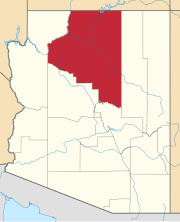Havasupai
In 1975, the tribe succeeded in regaining approximately 185,000 acres (75,000 ha) of their ancestral land with the passage of the Grand Canyon National Park Enlargement Act.[5] As a means of survival, the tribe has turned to tourism, attracting thousands of people annually to its streams and waterfalls at the Havasupai Indian Reservation.Although living primarily above and inside the Grand Canyon, which consists mostly of harsh terrain, the tribe's reservation was also home to some lush vegetation and the aquamarine blue water of Havasu Creek.[9] Garcés reported seeing roughly 320 individuals in his time with the Havasupai, a number that would diminish over the centuries as westward expansion and natural catastrophes significantly decreased the population size.[10] In the first half of the 19th century, with the exception of the introduction of horses by the Spanish, U.S. westward expansion affected the Havasupai less than it did other indigenous populations of the West.An executive order by President Rutherford Hayes in 1880 established a small federally protected reservation for the tribe, yet it did not include the mining areas along the Creek (Hirst, 1985).[4] In 1882 President Chester A. Arthur issued an executive order that all land on the plateau of the canyon, which was traditionally used for winter homes for the tribe, was to become public property of the United States.[12] The loss of almost all of their land was not the only issue that the Havasupai were contending with: the increase in the number of settlers in the local region had depleted game used for hunting, and soil erosion (a result of poor irrigation techniques) touched off a series of food shortages.[9] Issues regarding health within the Havasupai population reduced its growth to the point where almost an entire generation was lost due to infant and child mortality.Breaking horses, working on farms, or even serving as employees of the Grand Canyon National Park were all options for tribal members.Although the case was a landmark for the Havasupai in the sense that it was proven in a court of law that the federal government had inappropriately taken their land, it had still not been properly returned to the tribe.In 1974, garnering support from the Nixon administration as well as influential newspapers such as the Los Angeles Times, the Wall Street Journal, and the San Francisco Chronicle, the tribe made their push to have the congressional bill S. 1296, which would actually return their land, passed through Congress.Ranger Gale Burak, who worked at the Grand Canyon for several years, spoke of her experiences as a cook for the Havasu Lead and Zinc Company hard rock mining camp,[15] where the campground now resides.In 2003, protests ensued when it was found that Arizona State University had used blood samples consensually acquired from the Havasupai people to "study the causes of behavioral/medical disorders," with an initial goal of determining whether the high rates of Type 2 diabetes among Havasupai adults were due to the same gene that causes high rates of diabetes in the Pima people.[19] This included one that indicated that their ancestors migrated from Asia to North America, which contradicts the traditional Havasupai belief that the tribe originated in the canyon.[18] It has since been claimed that scientific study of Native Northern American genomes has been hampered due to scientists' fears of getting caught up in a similar legal predicament.[11] In 1920, to combat the issue, the federal government assisted the tribe in constructing a new irrigation system which was generally effective in ceasing soil erosion from water overflows.It is home to around 400[17] of the tribe members and is one of the most remote cities in the contiguous United States, as it can only be accessed by taking old U.S. Route 66 and traveling about 60 miles (100 km) along BIA Road 18 to the trailhead.The trailhead is at Hualapai Hilltop, Arizona (located at the end of BIA Road 18), where there is a large parking lot, a helipad, and portable toilets.









Havasupai TrailHavasu FallsHavasu CreekHavasupai–HualapaiSupai, ArizonaHavasupaiEnglishChristianityYavapaiHualapaiNative AmericanGrand CanyonDelawaresilver rushSanta Fe Railroadnational parkNational Park ServiceHavasupai Indian ReservationaquamarineFrancisco GarcésSouthern Paiutechildbearingpopulation bottleneckfair market valuevanadiumArizona State Universityblood samplesType 2 diabetesPima peoplemigrated from Asia to North AmericaconsanguinitycandytuftBureau of Indian AffairsIndian Health ServiceHavasupai languageUpland Yuman languageNative American languageYavapai languageCoconino Countycontiguous United StatesU.S. Route 66BIA Road 18helipadGrand Canyon National ParkIn the House of Stone and LightMartin PageUniversity of Arizona PressWayback MachineGriffin-Pierce, TrudyUniversity of ArizonaDobyns, Henry F.Garland PublishingBlack Suspension BridgeBridge Canyon DamGrand Canyon EscaladeGrand Canyon SkywalkGrand Canyon Village, ArizonaKolb StudioMarble Canyon DamMaswik LodgePhantom RanchGeologyAgave phillipsianaApollo TempleBat Cave mineCardenas BasaltDox FormationEricameria arizonicaEsplanade SandstoneGrand Canyon CavernsGrand Canyon Forest ReserveGrand Canyon–Parashant National MonumentGrand Canyon SupergroupChuar GroupNankoweap FormationSixtymile FormationUnkar GroupBass FormationShinumo QuartziteGrand StaircaseFreya CastleHakatai ShaleHermit FormationHyaloclastite DamIsis TempleKanab PlateauNewton ButteOchoa PointProspect DamRedwall LimestoneTanner GrabenTemple ButteTonto GroupBright Angel ShaleToroweap FaultUinkaret volcanic fieldVasey's ParadiseVenus TempleVishnu TempleVulcan's ThroneColorado RiverDeer CreekKanab CreekLittle Colorado RiverBright Angel CreekHarvey ButchartColin FletcherKenton GruaJohn HanceEventsPowell Geographic Expedition of 18691956 Grand Canyon mid-air collisionGrand Canyon Airlines Flight 6Grand Canyon Backcountry CampingList of trails in Grand Canyon National ParkNational Register of Historic Places listings in Grand Canyon National ParkGrand Canyon ConservancyGrand Canyon SuiteDesert WonderlandGrand Canyon (1958 film)A Bigger Grand CanyonGrand Canyon (2017 children's book)The Man Who Walked Through TimeIndigenous peoplesArizonaChemehuevi